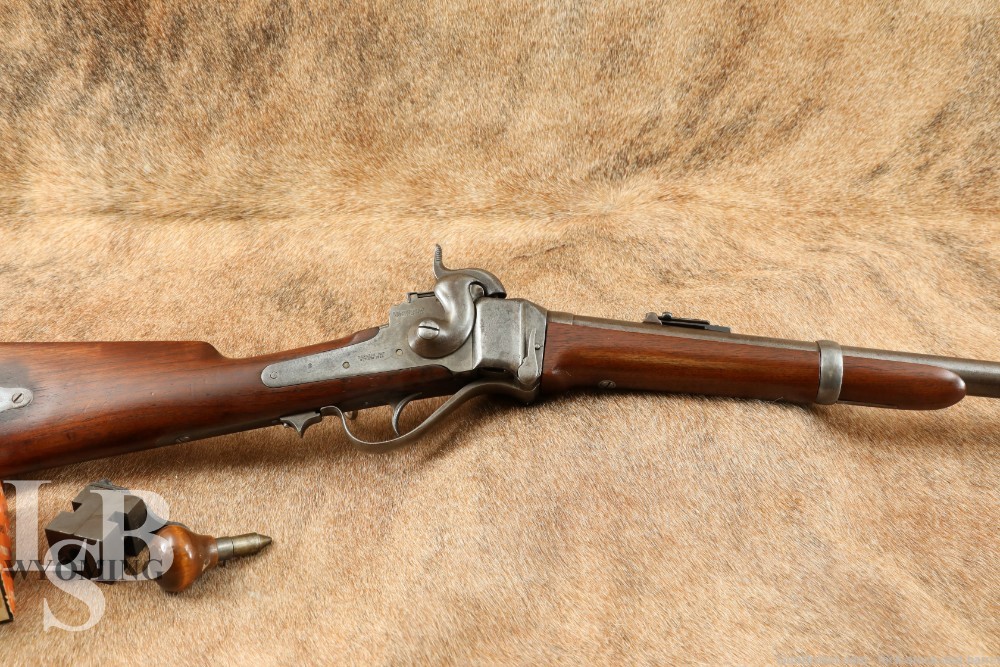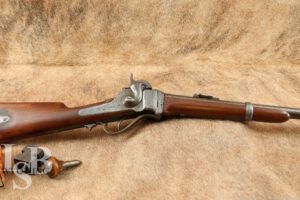
C. Sharps 1859 Carbine 52 Cal Percussion Cap Single Shot Civil War Rifle
SOLD FOR: $3,156.00
LSB#: WY240911JW008
Make: C. Sharps
Model: New Model 1859 Carbine
Serial#: 53539
Year of Manufacture: This rifle was originally manufactured between 1859 to 1862. The serial number range for these was from approximately 30,000-75,000. Putting this example at almost exactly mid production. Antique.
Caliber: .52 Caliber percussion cap rifle.
Action Type: Single Shot Lever Operated Falling Block Breach Loading Percussion Cap Rifle with single trigger. Half cock safety.
Markings: The top of the barrel is marked in several places and the markings are very hard to read. I will convey the legible portions here. In front of the rear sight is marked “SHARPS RIFLE / CO / RTFORD CONN.” On the rear sight “LAWRENCE / 1859”. Then there is an illegible marking behind the rear sight. The left side of the receiver is marked “C.SHARPS PAT. SEPT 12 1848.”. The top tang is marked “53539”. The right side of the receiver is marked “R.S. LAWRENCE’PAT / APRIL 12TH 1859” and “C.SHARPS’PAT. OCT.5TH 1852”. Under the forend is marked “5359X”.
Barrel Length: 22”
Sights/ Optics: The front sight is a brass blade fixed by the muzzle. The rear sight is a ladder which presents a “V’-notch in the down position. When raised, the rear sight presents an integral “V”-notch at the top, a “V”-notch slider and is marked 2-8. The rear sight is dovetailed to the barrel with a screw set leaf spring.
Stock Configuration & Condition/ Grip: The furniture set is a two-piece smooth wood featuring a forend that is secured with a screw and mounted with a barrel band secured by a spring. The stock features a straight hand, a sling bar with fixed saddle ring, a straight comb, a patchbox and a metal butt-plate. The LOP is 13.75” from the trigger to the rear end of the butt-plate. The forend shows scattered compressions, and scratches with a large repaired kraken the left side running from the barrel band to the receiver. The stock shows scattered lines and compressions with some nicks out of the comb, and some scattered dents. The patchbox functions correctly and contains an extra nipple. The metal buttplate has lost its finish, turned brown in places with patina and developed surface rust. Overall the furniture on this rifle is in Excellent condition especially considering the rifle is over 160 years old.
Type of Finish: Originally Blued, and Case Colored.
Finish Originality: Original
Bore Condition: The bore is gray with defined visible rifling. There is erosion and pitting scattered throughout the bore with heavier pitting in the transition between the second third and last third of the bore. In this writer’s opinion the bore rates 6.5/10.
Most antique firearms have bores that will show erosion. This is not only due to age but also to the use of black powder. When fired, black powder reacts corrosively.
Overall Condition: The carbine retains almost none of the original metal finish. The metal surfaces show patina scattered throughout with dings and nicks. The receiver has a faint case color hue that is visible in the right lighting. The inside of the action and breech face show pitting. The screwheads are sharp and the action does function correctly. The markings range from very clear to very faint. Overall this rifle rates in my opinion in Very Good + to Excellent condition for a rifle that is over 160 years old.
Mechanics: The action functions correctly. We did not fire this carbine. As with all used firearms, a thorough cleaning may be necessary to meet your maintenance requirements
Box Paperwork and Accessories: This carbine includes Lyman Bullet Mold Blocks.
Our Assessment: The C. Sharps Model 1859 Percussion Cap Breech-Loading Carbine is one of the most iconic firearms of the mid-19th century, known for its innovative design and extensive use during the American Civil War. Designed by Christian Sharps, the Model 1859 introduced a highly efficient breech-loading mechanism, which allowed for significantly faster reloading compared to traditional muzzleloaders of the time. This made it a preferred choice for cavalry units on both sides of the conflict, as well as for early sharpshooters.
Chambered in .52 caliber, this carbine fired a paper cartridge ignited by a percussion cap. The breech mechanism, operated by a lever that also served as the trigger guard, used a gas seal system to prevent blowback, which was a significant advancement. Its 22-inch barrel made the carbine compact and maneuverable, ideal for mounted troops who required a lightweight and reliable weapon. The effective range of the Model 1859 was superior to most muzzleloaders.
This particular example, made around 1861, would have likely seen service during the Civil War. The Sharps carbine was issued widely to Union cavalry regiments and became synonymous with battlefield innovation. This percussion cap breech loading system, while eventually replaced by metallic cartridges, was state-of-the-art at the time and offered faster reloading under combat conditions. Original specimens like this one are highly collectible and serve as significant artifacts of Civil War history, representing a major step in the evolution of firearm technology. To better understand this rifle please see our high quality photos via the link and best of luck with your bidding!!!-R.L.

